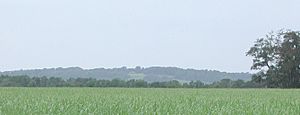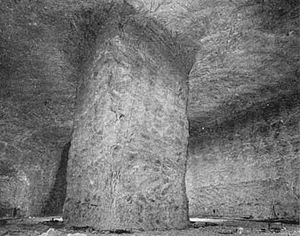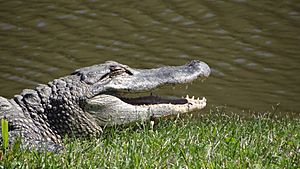Avery Island (Louisiana) facts for kids
Quick facts for kids
Avery Island
Île Petite Anse
|
|
|---|---|

Avery Island as seen from a distance across a sugarcane field
|
|
| State | Louisiana |
| Parish | Iberia |
| Founded by | John Craig Marsh |
| Named for | Judge D. Avery |
| Time zone | UTC-6 (CST) |
| • Summer (DST) | UTC-5 (CDT) |
| ZIP code |
70513
|
Avery Island is a special place in Louisiana, United States. It's famous for being where Tabasco sauce comes from! Even though it's called an "island," it's actually a giant mound of salt underground.
This unique spot is about 3 miles (5 km) from Vermilion Bay. That bay leads out to the Gulf of Mexico. A small number of people live on Avery Island. It is also listed as a historic place.
History
Long ago, Native Americans found something amazing here. They discovered that the island's green plants hid a huge natural treasure: a giant salt dome. They would boil the salty spring water to get salt. Then, they traded this salt with other tribes. These tribes lived as far away as Texas, Arkansas, and Ohio.
By 1818, the island was known as Petite Anse Island. That year, John Craig Marsh bought it. He started a sugar plantation on the island's rich soil. In 1837, his daughter Sarah married Daniel Dudley Avery. Daniel was a judge from Baton Rouge. He became a co-owner of the plantation in 1849. By 1855, he owned the whole island.
Edmund McIlhenny joined the Avery family before the Civil War. He married Daniel and Sarah's daughter, Mary Eliza Avery. In 1868, McIlhenny started the McIlhenny Company. This company began making Tabasco brand pepper sauce. He received a special patent for his sauce recipe in 1870. The same basic way of making Tabasco is still used today!
In 1938, Edmund's son, Edward Avery McIlhenny, started a nutria farm on Avery Island. Nutrias are large rodents from South America. For reasons we don't know, Mr. McIlhenny let many nutrias go free. From Avery Island, they spread out across the area.
In September 2005, Hurricane Rita hit Avery Island hard. The family spent $5 million to build a 17-foot (5.2 m) high levee. They also added pumps and backup power. This helps make sure future hurricanes won't stop Tabasco sauce production.
Bird sanctuary
The Avery and McIlhenny families have helped protect Avery Island. Many animal species live there. Edward Avery McIlhenny, also called "Mr. Ned," started a bird colony around 1895. He did this because hunters were killing thousands of egrets. They wanted the egrets' feathers for ladies' hats.
Mr. Ned gathered eight young egrets. He raised them safely on the island. Then, he released them in the fall to fly across the Gulf of Mexico. The next spring, these birds came back to the island. They brought many other egrets with them. This amazing bird migration still happens every year. Mr. McIlhenny also wrote and drew about the plants and animals on Avery Island. His work is now in the Louisiana State University library.
Non-native plants
Edward McIlhenny brought many new plants to the island. These included different kinds of azaleas, camellias, and papyrus sedge. In 1942, oil was found on the island. Mr. McIlhenny made sure that oil workers protected the old live oak trees. He also made them bury pipelines or paint them green. This helped keep the island beautiful.
Today, you can visit Jungle Gardens and Bird City. They are open to the public.
Geography
Avery Island is surrounded by bayous (slow rivers), salt marsh, and swampland. It is about 130 miles (209 km) west of New Orleans. The island used to be a sugar plantation. It was known as Petite Anse Island. Petite Anse means "Little Cove" in Cajun French. You can get to the island by a road that used to have a small toll. Now, visitors don't have to pay to enter.
At its highest point, the island is 163 feet (50 m) above sea level. It covers about 2,200 acres (8.9 km²) of land. It is about 2.5 miles (4 km) wide at its widest part.
Geology
Avery Island is actually a huge dome of rock salt. It is about 3 miles (5 km) long and 2.5 miles (4 km) wide. This salt dome formed from ancient salt deposits deep underground. These deposits pushed up towards the surface. Avery Island is one of five "salt dome islands" in Louisiana. These islands rise above the flat Louisiana Gulf coast. The five islands are Jefferson Island, Avery Island, Weeks Island, Cote Blanche Island, and Belle Isle.
Education
The Iberia Parish School System runs the public schools in the area. Students from Avery Island go to schools in New Iberia. They attend Center Street Elementary School, Iberia Middle School, Westgate High School, and New Iberia Senior High School.
Avery Island Elementary School used to serve the community. It taught students from kindergarten to sixth grade. After the 2007–2008 school year, students moved to Center Street Elementary School. About 118 children went to Avery Island Elementary at that time.
The area is also served by Fletcher Technical Community College and South Louisiana Community College.
In popular culture
- Avery Island is the name of the first album by the band Neutral Milk Hotel. The album is called On Avery Island.
- The island was featured in the movie Louisiana Story.




